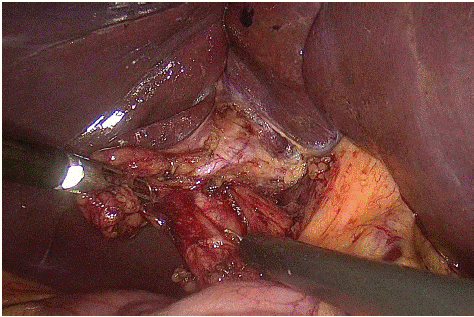
Clinical Image
Austin J Surg. 2024; 11(3): 1330.
Agenesis of the Gallbladder: Clinical Image of a Diagnosis Challenge
Rebbani Mohammed1,2*; El Brahmi Yasser1; Rahali Anwar1; Njoumi Nourddine1; Abderrahman Elhjouji1; Aziz Zentar1; Ait Ali Abdelmouain1
¹Department of Visceral Surgery, Morocco
²HMIMV, Rabat, Morocco
*Corresponding author: Rebbani Mohammed Department of Visceral Surgery, HMIMV, Rabat, Morocco. Email: mohammed.rebbani@gmail.com
Received: July 19, 2024 Accepted: August 26, 2024 Published: September 03, 2024
Clinical Image
Agenesis of the gallbladder is an underdiagnosed and very rare entity unfamiliar to physicians with an incidence rate of 0.01% to 0.06%. [1]. The etiology is still under research, but it is generally accepted as a congenital malformation, Gallbladder agenesis is believed to occur from the failure of the gallbladder bud to develop or failure of the partially formed gallbladder to recanalize during intrauterine life [2]. Symptomatic agenesis of the gallbladder manifest with biliary symptoms, including 90% with right upper quadrant pain, 60% with nausea and vomiting, 37% with food intolerance, 35% with jaundice, and 30% with dyspepsia. symptoms have been attributed to biliary dyskinesia that possibly are caused by heightened tone in the sphincter of Oddi that increased pressure in the biliary tree with the absence of a gallbladder as a pressure reservoir [3]. The diagnostic is very challenging and can lead to unnecessary diagnostic tests and interventions in almost cases [4]. radiologists might doubt if they do not find the gallbladder and might mistake it with a shrunken gallbladder or porcelain gallbladder. if doubts exist, further investigations are required to confirm the diagnosis and avoid unnecessary surgeries. Treatment is symptomatic [5]. Therefore, Surgeons and radiologists needs to keep this pathology on their list of differential diagnoses to avoid dangerous and unnecessary procedures [6]. We report an image of a young man of 35 years old that present with sclera trophic gallbladder on ultrasound and surgical findings confirms gallbladder agenesis.

Figure 1: Coelioscopic picture showing a principal biliary duct without any presence of the gallbladder.
References
- Waller AH, Goralski JL, Brelvi ZS. Agenesis of the gallbladder. Clin Gastroenterol Hepatol. 2008; 6: A28.
- Piltcher-da-Silva R, Sasaki VL, Felisberto DEG, Bodanese BCS, Piltcher-Recuero M, Bodanese BVS, et al. Gallbladder agenesis a rare and underdiagnosed congenital anomaly: a case report and literature review. J Surg Case Rep. 2022; 2022: rjac505.
- Arias Rivera AS, Jasqui Bucay A, Mandujano I, Perez Cantu A, De Leon D. Gallbladder Agenesis: Must General Surgeons Have It on Their Diagnostic Algorithm? Cureus. 2023; 15: e51078.
- Molina G, Ayala AV, Arcia AC, Jiménez GE, Proaño EJ, Cadena CA, et al. Agénésie de la vésicule biliaire découverte lors d'une intervention chirurgicale, une somme de décisions inadéquates. Annales de Médecine et de Chirurgie. 2022; 77: 103585.
- Bouche M, Mesureur S, Forzini T, Buisson P. Coliques hépatiques révélant une agénésie de la vésicule biliaire : un diagnostic préopératoire difficile [Isolated gallbladder agenesis mimicking biliary colic: A difficult preoperative diagnosis]. Arch Pediatr. 2017; 24: 634-636.
- Peloponissios N, Gillet M, Cavin R, Halkic N. Agenesis of the gallbladder: a dangerously misdiagnosed malformation. World J Gastroenterol. 2005; 11: 6228–6231.